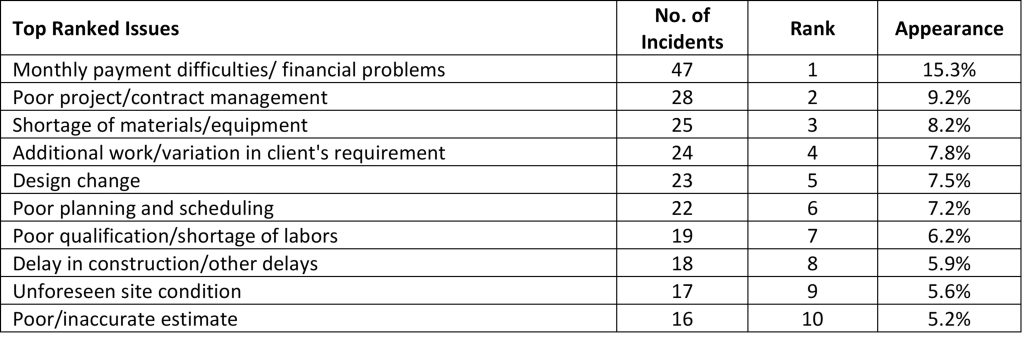
11 May It’s a People Issue, not a Technical Issue | Construction Performance
*This is a summary and analysis of the following publication. For full references and research details, please see original publication.
Rivera, A., et.al., (2016). Identifying the Global Performance of the Construction Industry. Journal for the Advancement of Performance Information and Value, 11(1), 34-51.
Available at: http://journal.cibw117.org/index.php/japiv/issue/view/10
Construction Performance Worldwide Study
The demand for construction around the world is rapidly increasing as populations grow. Construction development will be greater in the next 30 years than in the last 2,000. As projects become increasingly more complex due to increased size, number, and supply chain participants, project managers are having difficulty delivering services on time, on budget, and with high customer satisfaction. Construction performance appears to be suffering in every country around the world and all countries seem to be experiencing similar issues.
In an effort to identify the level of performance in the industry, potential issues, and solutions, a global construction performance research study was conducted in 2016 by CIB Working Commission 117. The study included 38 major countries. Performance was measured by rework, cost overrun, schedule delay and customer satisfaction. After reviewing over 3,200 publications, 95 were found to have performance documentation. The results of the study identified that on average (see Table 1):
- Rework by contractors adds 2-20% of expenses to a contractor’s bottom line.
- 68% of projects had cost overrun with an average of 23% over budget.
- 74% of projects experience delay with an average of 42% delay.
- Over the past ten years, publications consistently report a poor customer satisfaction.
Compared to the other countries shown in Table 1, North America appears to have the largest percentage of projects with delays and budget deviations. This information may not be reliable because these numbers come from only two sources, while the other countries have many different sources (Lepatner 2007, IHS Markit, 2013). The authors believe that project performance in North American is likely very similar to other developed countries, but more research is needed.
Table 1: Worldwide Construction Performance

Contrary to popular belief that modern countries have an advantage over third world countries, poor performance was the same in every examined country (Liu, 2016). In comparison, a similar worldwide construction study showed similar findings (CII, 2015):
- 5% of projects defined as successful (scope, cost, schedule, & business).
- 25 to 50% waste in coordinating labor on a project.
- Management inefficiency costs owners between $15.6 and $36 billion per year.
- An estimated $4 billion to $12 billion per year is spent to resolve disputes and claims.
Even more recently, in a worldwide study of construction cost overrun, a global operations and enterprise IT expert that measures and tracks progress of construction worksites, identified that over the past 70 years, 85% of projects are overrun by an average of 28% (Propeller, 2020).
The Top Ten Major Issues in Construction
 The global study also investigated the reason construction project performance has stagnated (see Table 2). The study lists the top 10 major construction issues, which make up 78% of all causes of non-performance reported. The list comes as no surprise as these performance issues have been continuously cited in literature for years. The observation made by the authors is that the issues themselves are not as important as the type of issues that are occurring. Contrary to the assumed source of risk being technical or complex, the type of issues was primarily “people issues”, which often worsened due to poor planning, coordination, and communication with those people.
The global study also investigated the reason construction project performance has stagnated (see Table 2). The study lists the top 10 major construction issues, which make up 78% of all causes of non-performance reported. The list comes as no surprise as these performance issues have been continuously cited in literature for years. The observation made by the authors is that the issues themselves are not as important as the type of issues that are occurring. Contrary to the assumed source of risk being technical or complex, the type of issues was primarily “people issues”, which often worsened due to poor planning, coordination, and communication with those people.
For instance, design changes are not the source of issues, however when done later in the project or past specific cut off times, a design change can cause significant rework. This isn’t necessarily a technical issue, but it requires coordination of when changes can occur and clear communication to the stakeholders of the impact of each change (time and cost) before it is done. The same can be said about poor/inaccurate estimates. Poor or inaccurate estimates are often inevitable, but they cause issues when there is no clear distinction that it is an estimate and no clear plan to confirm the actual information.
At least nine of the listed ten issues are not necessarily technical but are issues created by nonexpert personnel which could easily be mitigated with an expert who properly planned, coordinated, and communicated with the project stakeholders. In other words, the solution is not a technical solution, but requires an expert who understands people and can include these people in their plan.
Table 2: Top 10 Performance Issues

A Potential Solution to Low Performance
The Performance Based Studies Research Group (PBSRG), through their independent analysis and testing on over 2,000 projects have confirmed that the industry’s cause of non-performance is a “people problem” and not a “technical problem”. In fact, they identified that 90% of risk is caused by nonexpert stakeholders. In order to overcome these issues, PBSRG has specialized in an approach and process to identify and utilize experts. They have found that expertise can create transparency and simplistic planning, which minimizes the “people factor” of a project. Their approach has been labeled the Best Value Approach or BVA. The BVA can be used to deliver any project from RFP creation to project execution. The BVA is documented to cut project cost by 10-30% through the utilization and identification of expertise, to minimize risk of nonexpert stakeholders.
To learn more about the Best Value Approach and how this can be done see the following relevant resources:
- Free membership for latest tips and news: https://pbsrg.com/membership/
- For latest books, events, and licensed partners: https://pbsrg.com/resources/
- Latest BVA journal publications: www.cibw117.org/
- Annual Best Value Conference in January: https://bestvalueconference.ksm-inc.com/
- Latest presentations and videos: https://www.youtube.com/channel/UCxBi26nXLDTqG4ZRV6p0iiQ
Additional References
IHS Markit (2013). Public Annual Reports; press releases. IHS Herold Global Projects Database. Retrieved from: http://www.herold.com/research/industry_research.home
Lepatner, B.B. 2007. Broken Buildings, Busted Budgets. The University of Chicago Press, Chicago.
Propeller Aerobiotics (2020). 10 Construction Project Cost Overrun Statistics You Need to Hear. Propeller Aerobiotics. Web. (2022). Retrieved from: https://www.propelleraero.com/blog/10-construction-project-cost-overrun-statistics-you-need-to-hear/#:~:text=Here%20are%20the%20numbers%20that,the%20bat%20for%20cost%20overrun


